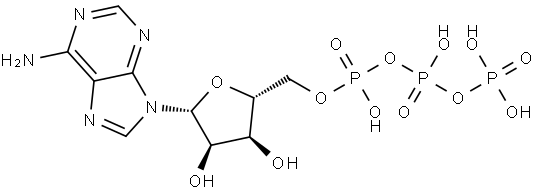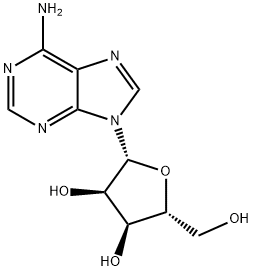Adenosine triphosphate , 95% , 56-65-5
CAS NO.:56-65-5
Empirical Formula: C10H16N5O13P3
Molecular Weight: 507.18
MDL number: MFCD00065467
EINECS: 200-283-2
| Pack Size | Price | Stock | Quantity |
| 1g | RMB24.00 | In Stock |
|
| 5g | RMB40.00 | In Stock |
|
| 10g | RMB75.20 | In Stock |
|
| 25g | RMB152.80 | In Stock |
|
| 100g | RMB570.40 | In Stock |
|
| others | Enquire |
PRODUCT Properties
| Melting point: | 144°C (rough estimate) |
| alpha | D22 -26.7° (c = 3.095) |
| Boiling point: | 951.4±75.0 °C(Predicted) |
| Density | 1.0 g/mL at 20 °C |
| storage temp. | Keep in dark place,Inert atmosphere,Store in freezer, under -20°C |
| solubility | Soluble (water), Na and K salts are easily soluble in water, Ba salts are insoluble in water |
| form | lyophilized powder |
| pka | pK2: 4.00(-1);pK3: 6.48(-2) (25°C) |
| color | White to off-white |
| Water Solubility | Water : ≥ 100 mg/mL (197.17 mM) |
| InChIKey | ZKHQWZAMYRWXGA-KQYNXXCUSA-N |
| SMILES | C(OP(=O)(O)OP(O)(=O)OP(O)(O)=O)[C@H]1O[C@@H](N2C3C(=C(N=CN=3)N)N=C2)[C@H](O)[C@@H]1O |
| LogP | -4.180 (est) |
| CAS DataBase Reference | 56-65-5(CAS DataBase Reference) |
| EPA Substance Registry System | Adenosine triphosphate (56-65-5) |
Description and Uses
Adenosine triphosphate, also known as ATP, is a molecule that carries energy within cells. It is one of the most important biological compounds because of its role in supplying energy for life. ATP is the universal energy carrier used by all organisms to supply energy for biological functions. It is often referred to as the energy currency of cells.
ATP also functions as a neurotransmitter that is stored and secreted with other neurotransmitters from the pancreas. ATP is a nucleotide consisting of the nucleoside adenosine with three attached phosphate groups (see Adenine). Like other nucleotides, ATP consists of three parts: a sugar, an amine base, and a phosphate group. The central part of the molecule in ATP is the sugar ribose. The amine base adenine is attached to the ribose, forming adenosine. Opposite the adenine on the ribose is attached a chain of three phosphate groups.
Adenosine triphosphate (ATP) plays a critical role in the transport of macromolecules such as proteins and lipids into and out of the cell. The hydrolysis of ATP provides the required energy for active transport mechanisms to carry such molecules across a concentration gradient.
Safety
| Safety Statements | 22-24/25 |
| WGK Germany | 3 |
| Toxicity | dni-hmn:lym 10 mmol/L CNREA8 42,2092,82 |



